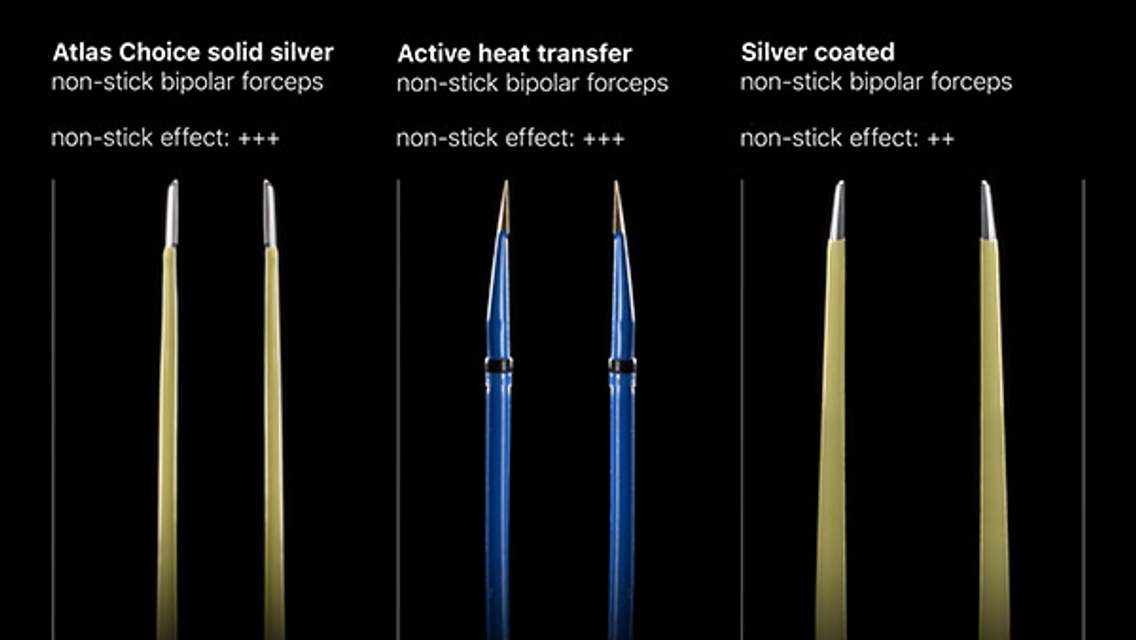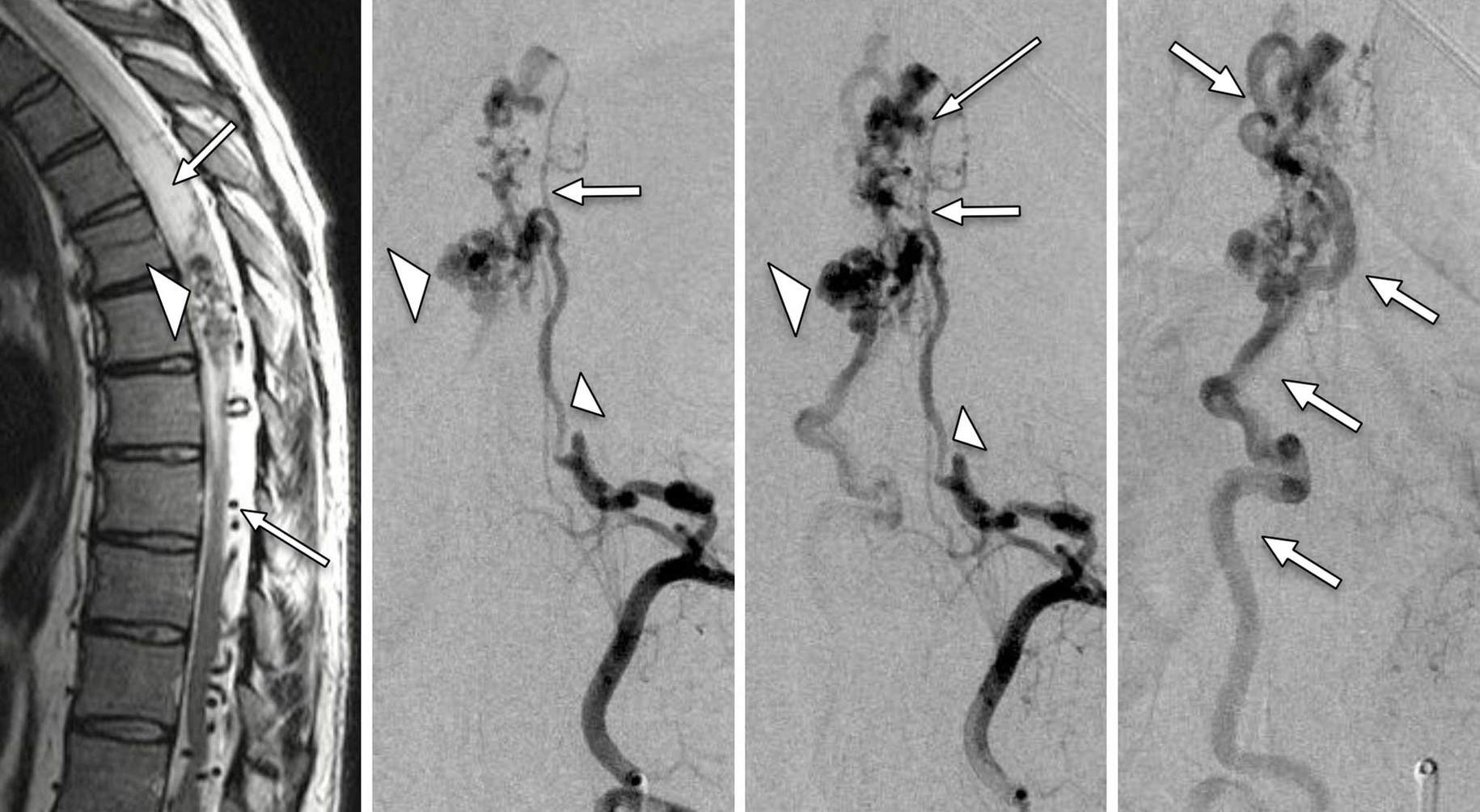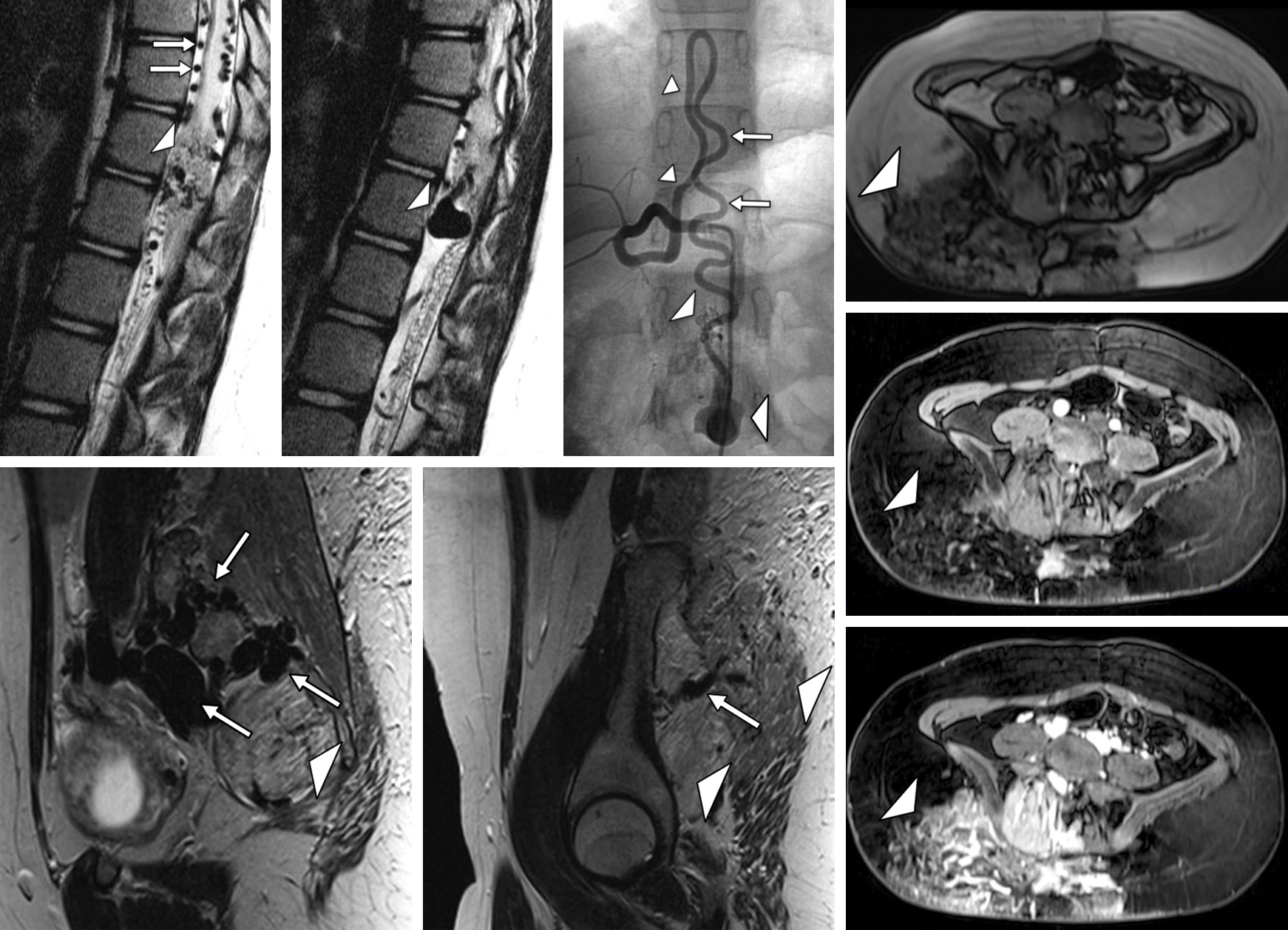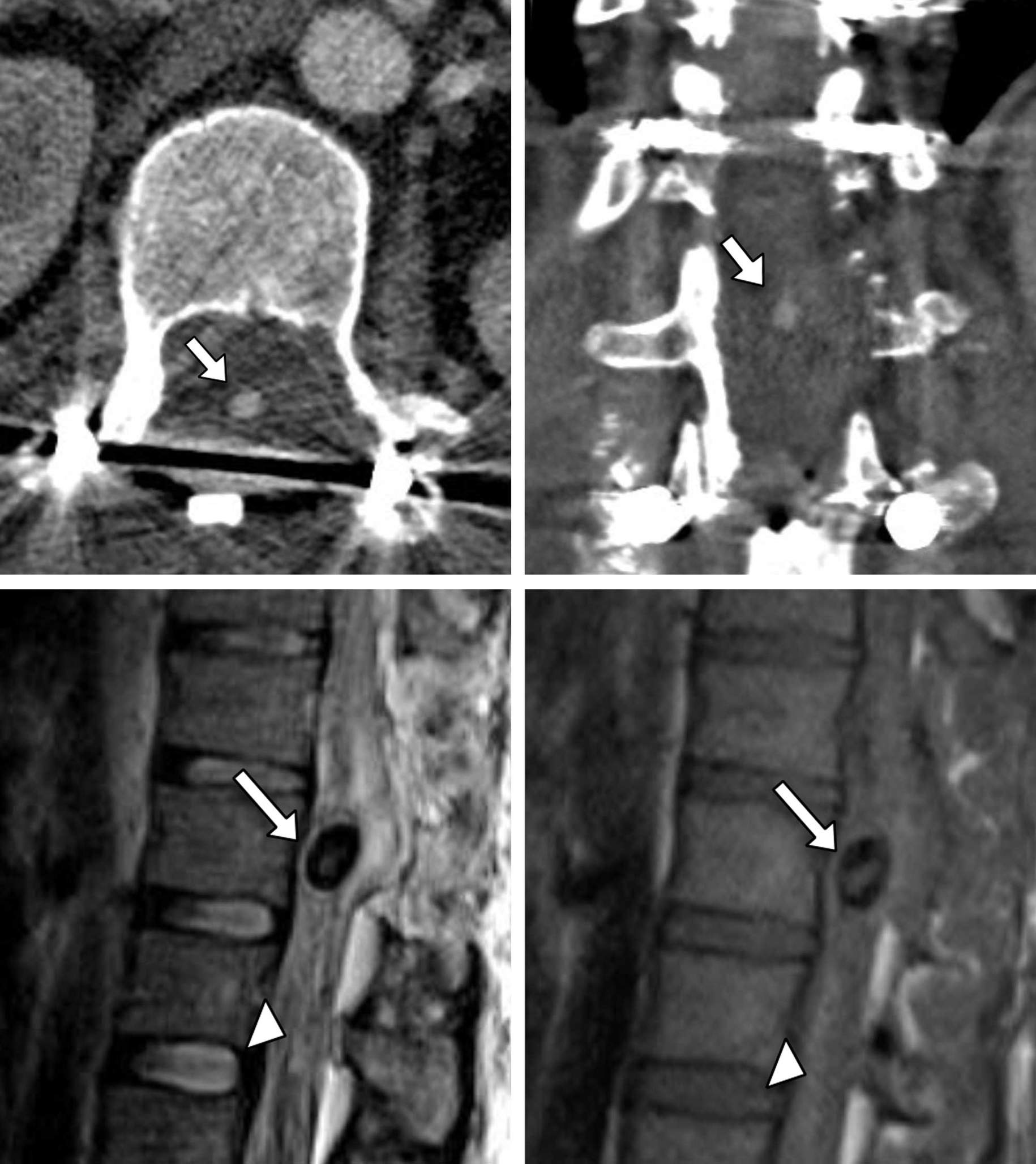Spinal Vascular Malformations
Overview
The spinal vascular malformations are in many ways analogous to their intracranial counterparts. Lesions characterized by high flow shunts include spinal arteriovenous fistulas (AVF) and spinal arteriovenous malformations (AVM). The most common classification scheme for spinal vascular malformations uses the Type 1 to 4 classification system, though other classification schema exist.
Type 1 lesions are dural AVFs in which a radiculomeningeal artery forms a fistulous communication with dural veins at the nerve root sleeve, and result in subsequent arterialization of the perimedullary venous plexus. Type 2 AVMs have an intramedullary nidus with variable anterior spinal artery (ASA) and/or posterior spinal artery contributions. Some authors treat conus medullaris AVMs as separate entities, though the angioarcitecture is similar. Type 3 lesions are known as juvenile or metameric AVMs with both extradural and intradural involvement. The classic Cobb syndrome is limited to metameric-origin malformations involving the spinal cord, bone, and skin.
The spinal arteriovenous metameric syndrome (SAMS) describes all forms of metameric malformations, even if the AVM does not involve the spinal cord. Type 4 spinal AVMs, refer to ventrally-located perimedullary fistulae on the pial surface, within the subarachnoid space, primarily receiving arterial contributions from the ASA. These have been subcategorized into A, B, and C based on size and complexity; venous hypertension and aneurysms are often complications of the latter. Other related entities introduced in this section include extradural (epidural) AVF and vertebral arteriovenous fistulas (vertebrovenous fistula).
Dural Arteriovenous Fistula (Type I)
Type 1 lesions are dural AVFs in which a dural branch from a radicular artery (radiculomedullary/radiculomeningeal) forms an abnormal communication with the dural veins at the nerve root sleeve, under the pedicle of the vertebral body. Arterialization of the perimedullary venous plexus results. This is the most common spinal vascular malformation, accounting for 70% of vascular malformations of the spine.
Figure 1: 81 year old F with myelopathy. T2W Sagittal MRI demonstrates hyperintense intramedullary cord signal (black arrow, left image) and multiple extramedullary hypointense flow voids representing arterialized perimedullary veins (white arrows, center image). L4 lumbar artery angiogram demonstrates a slow flow, spinal dural arteriovenous fistula arising from the right L4 radicular branch (white arrow, right image). Venous drainage is cephalad into the perimedullary venous plexus (black arrows, right image).
Figure 2: 64 year old M with myelopathy. T2W Sagittal MRI demonstrates hyperintense intramedullary cord signal (white arrow, left image) and multiple extramedullary hypointense flow voids representing congested perimedullary veins (white arrows, center image). Right T11 segmental artery angiogram demonstrates a dural arteriovenous fistula associated with the right T11 radicular artery. The intradural component begins at the right T11 nerve root (bottom arrow, right image), ascends in the left lateral canal to the superior margin of the T10 vertebral body (upper arrow, right image)
Figure 3: 62 year old F with spontaneous intracranial subarachnoid hemorrhage. Left vertebral artery angiography in LAO projection (left image) and left lateral projection (center image) demonstrate a dural arteriovenous fistula with arterial supply from the left C4 radicular branch (white arrows) and cephalad venous drainage via the anterior spinal vein (black arrows). Intra-operative angiogram (right image) demonstrates complete occlusion of cervical spinal dural AV fistula status post microsurgical ligation (white arrow).
Intramedullary AVMs (Type II)
Intramedullary AVMs are analogous to intracranial AVMs, with nidus located entirely in the spinal cord parenchyma. The nidus can be characterized by compact or diffuse angioarchitecture. Single or multiple feeding arteries from branches of the ASA and/or posterior spinal artery.
Figure 4: 38-year-old M with rapid onset mid-thoracic Brown-Sequard syndrome. T2W MRI demonstrates hyperintense intramedullary cord signal (upper arrow, left image), mid-thoracic nidus at the T6 vertebral level (arrow head), and serpiginous intra-dural flow voids (bottom arrow, left image). Left T7 segmental artery angiography in demonstrate a mid-thoracic intramedullary AVM nidus (large arrow head, center images). The dominant and most direct supply arises from anterior spinal arterial feeders (small arrow head) supplied by the left T7 radiculomedullary artery. Several nidal aneurysms are noted. Tortuous, arterialized perimedullary veins (arrows, right image) drain the nidus.
Conus Medullaris AVMs
Conus Medullaris AVMs have similar angioarchitecture with classic type II lesions, typically with multiple feeders from the ASA and posterior spinal artery, direct arteriovenous shunts, and large dilated veins. These lesions are generally attributed to a neurulation abnormality and are often associated with tethered cord phenomenon. Progressive myeloradiculopathy results with both upper motor neuron symptoms secondary to venous hypertension and ischemia as well as lower motor neuron symptoms secondary to mass effect from hugely dilated venous structures.
Figure 5: 56 year old male with myeloradiculopathy. T2W MRI demonstrates hyperintense intramedullary cord signal (arrow head, left image) just above the level of the conus and multiple serpiginous intra-dural flow voids (white arrows). Left T10 segmental artery angiography (center images) demonstrate a conus medullaris arteriovenous malformation (arrow head) supplied by the T10 radicular artery (black arrow head) and anterior spinal artery which is quite dysplastic (black arrows). Right internal iliac artery angiogram reveals anterior spinal arterial supply arising from the artery of Desproges-Gotteron (black arrows, right image).
Juvenile spinal AVM (Type III), Spinal Arteriovenous Metameric Syndrome (SAMS), and Cobb Syndrome
Type 3 lesions are metameric AVMs with both extradural and intradural involvement. The spinal arteriovenous metameric syndrome (SAMS) describes all forms of metameric malformations, even if the AVM does not involve the spinal cord. The classic Cobb syndrome is limited to metameric-origin malformations involving the spinal cord, bone, and skin. Cutaneous manifestations of Cobb syndrome are typically port-wine stains (PWS) or angiomas, but reports exist of angiokeratomas, angiolipomas, and lymphangioma circumscriptum. Lesions are difficult to treat, often with staged, multidisciplinary approach. May be more prone to aneurysm formation and rupture. In general, these conditions are extremely rare conditions.
Figure 6a: 23 year old male with large midthoracic vascular birthmark and suspected underlying vascular malformation. Angiography revealed multilevel metameric spinal arteriovenous malformations from T7 through T12 with bilateral arterial supply at these levels, involving the paraspinal soft tissue and osseous structures, without definite spinal cord involvement. Representative right T12 segmental artery angiogram demonstrates dysplastic paraspinal angioarchitecture (arrow heads).
Figure 6b: 23 year old male with large midthoracic vascular birthmark and suspected underlying vascular malformation. Right T9 segmental artery angiogram demonstrates high flow arteriovenous fistula (white arrow) with large varix (arrow heads).
Figure 6c: 23 year old male with large midthoracic vascular birthmark and suspected underlying vascular malformation. Right and left T11 segmental arterial angiograms demonstrating bilateral supply to the metameric AVM.
Figure 6d: 23 year old male with large midthoracic vascular birthmark and suspected underlying vascular malformation. Representative right T9 segmental artery angiograms, pre- and post-embolization (top row). The right T9 high flow shunt with large varix (arrow head), was embolized with detachable coils after the catheter was passed through the fistula into its venous side. Distal feeders arising beyond the arteriovenous fistula were embolized with acrylic. Representative right T11 segmental artery angiogram and unsubtracted image (bottom row). The T11 AV shunt, arising from its proximal intercostal artery was treated with detachable coils to occlude its varix (arrow head), as well as a combination of liquid coils and acrylic (arrows). In general, it is most important to close the lesion itself, such as an aneurysm, varix, fistula, or nidus, to obtain long-lasting effect. Proximal feeder occlusion tends to result in an incomplete transient effect due to parasitized collaterals.
Figure 7: 15 year old female with large vascular birthmark overlying the right flank and spinal AVM.
T2W MRI demonstrates hyperintense intramedullary cord signal, serpiginous signal flow voids surrounding the conus (arrows, right image), with a notably larger signal void at the T12-L1 level (arrow head). Right T10 segmental artery angiogram demonstrates a small intramedullary AVM (large arrow heads), arising from a dysplastic anterior spinal artery (arrows), and T10 radiculomedullary artery (small arrow heads). The ventral AV fistula and varix are noted.
MRI of the pelvis demonstrates abnormal T1 and T2 signal with associated post-contrast enhancement of the overlying skin and subcutaneous tissue of the right flank and lower back as well as the right erector spinae, piriformis, and gluteus maximus musculature (white arrow heads). Chemical shift India ink artifact on out-of-phase imaging confirms the presence of diffuse fat within the infiltrative vascular lesion. Multiple prominent, dilated blood vessels drain this region and communicate with the right iliac venous system. Several of these prominent veins are located within the right sacral neural foramina, resulting in mass effect on the right S1 nerve root and near-complete obliteration of the S2 and S3 neural foramina.
Intradural-Perimedullary AVF (Type IV)
Type 4 spinal AVMs, are ventrally-located perimedullary fistulae on the pial surface, within the subarachnoid space, primarily receiving arterial contributions from the ASA. Type 4 lesions can be acquired, post-traumatic or iatrogenic in etiology. Congenital lesions may be associated with genetic syndromes Klippel-Trenaunay/Parkes-Weber syndromes, Hereditary Hemorrhagic Telangiectasia (Osler-Weber-Rendu syndrome). These have been subcategorized into A, B, and C based on size and complexity. Venous hypertension and aneurysms are often complications of the latter.
Figure 8a: 34-year-old male with recent lumbar spine stabbing injury; L1 laminectomy with exploration of epidural collection was performed. Increasing paraparesis for 1 month. CT angiography of the lumbar spine, axial and coronal planes, demonstrates an ovoid focus of enhancement both ventrally and centrally located near the conus terminalis, representing a suspected pseudoaneurysm (arrows). Sagittal T2W and T2W postcontrast MRI of the thoracolumbar spine, demonstrates a T1 and T2 hypointense, ovoid lesion with central post contrast enhancement. Also noted are clumped nerve roots with enhancement indicating arachnoiditis, as well as loculated subdural enhancing collection (arrow head).
Figure 8b: 34-year-old male with recent lumbar spine stabbing injury; L1 laminectomy with exploration of epidural collection was performed. Increasing paraparesis for 1 month. Left T9 segmental artery angiogram. The artery of Adamkiewicz (black arrows) arises from the left T9 segmental artery. There is a small arteriovenous fistula at the terminal portion of the descending ramus, at the level of the conus. There is a small pseudoaneurysm (arrow heads) at the proximal venous side of the fistula with early filling of the conus perimedullary venous plexus (white arrows).
Extradural (Epidural) AVF
Extradural (Epidural) Arteriovenous Fistulas are abnormal communications between an extradural arterial branch that usually arises from a branch of a radicular artery and the epidural venous plexus. Two different types of spinal extradural AVFs have been described: (A) purely extradural lesions and (B) extradural lesions with intradural medullary venous drainage, with the fistula site located distally from the dural penetration site. Combination of upper motor neuron and lower motor neuron symptoms. Resultant engorgement of the venous plexus, leads to mass effect on adjacent nerve roots and spinal cord. Venous hypertension and vascular steal also may contribute to myelopathic symptoms.
Figure 9: 59 year old female with 1 month onset of myeloradiculopathy. Sagittal and axial T2W MRI of the thoracolumbar spine, demonstrated T2 hypointense prominent spinal surface flow voids along the left lateral epidural space (arrows). Left T12 artery segmental angiogram in LAO and AP projections, demonstrates abnormal venous outflow into the left posterolateral epidural venous plexus (arrows).
Vertebral AVF (Vertebral-Venous Fistula)
Vertebral arteriovenous fistulas (vertebral-venous fistula) are abnormal connections between the extracranial vertebral artery or its branches and neighboring veins. Common causes of these fistulas include: penetrating neck trauma; iatrogenic injuries (ie. insertion of venous catheters, complications of anterior interbody fusion); spontaneous/congenital in association with fibromuscular dysplasia or neurofibromatosis. Symptoms of neck pain, neurologic dysfunction do to steal phenomenon, venous hypertension, or mechanical compression.
Figure 10: 33 year old female with neurofibromatosis, history of neck pain 1 week prior to delivering child, presented with progressive right cervical radiculopathy and bruit over the right neck. Axial and sagittal T2 MRI demonstrates a markedly dilated flow void spanning the right C3-C4 foramen and right anterolateral epidural venous plexus resulting in cord compression. DSA, right vertebral artery injection (AP, Lat, Obl images) demonstrate irregular, fusiform dilatation of the C2 segment of the right vertebral artery with arteriovenous fistula at C3-C4 level, communicating with a markedly engorged epidural venous plexus. There is complete "steal" through the fistula with no antegrade filling of the right vertebral artery beyond the fistula.
Left vertebral artery injection (AP image, far left) demonstrates a normal cervical and intracranial left vertebral artery with retrograde filling of the V4, V3, and distal V2 segments of the right vertebral artery with subsequent filling of the arteriovenous fistula. The basilar artery artery and cerebellar branches are normal.
Contributors: Daniel Murph, MD; Andrew DeNardo, MD; John Scott, MD and Daniel Sahlein, MD
References
Berenstein A, Lasjaunias, P. Surgical Neuroangiography, Volume 5. Endovascular Treatment of Spine and Spinal Cord Lesions. Springer-Verlag, New York, 1992.
Choi IS. Spinal arteriovenous metameric syndrome: angioarchitecture and their prognosis. AJNR Am J Neuroradiol. 2013 Feb;34(2):464-5. doi: 10.3174/ajnr.A3318. Epub 2012 Aug 30.
Clarke MJ ,et al: Spinal extradural arteriovenous malformations with parenchymal drainage: venous drainage variability and implications in clinical manifestations. Neurosurg Focus 26(1):E5, 2009.
Ferrell AS, et al. Legacy and current understanding of the often-misunderstood Foix-Alajouanine syndrome. Historical vignette. J Neurosurg. 2009 Nov;111(5):902-6. doi:10.3171/2007.11.17656.
Hurst R, Rosenwasser R. Interventional Neuroradiology. 2008.
Niimi Y, Uchiyama N, Elijovich L, Berenstein A. Spinal arteriovenous metameric syndrome: clinical manifestations and endovascular management. AJNR Am J Neuroradiol. 2013 Feb;34(2):457-63. doi: 10.3174/ajnr.A3212. Epub 2012 Aug 2.
Novy J, et al. Spinal Cord Ischemia: Clinical and Imaging Patterns, Pathogenesis, and Outcomes in 27 Patients. Arch Neurol. 2006;63(8):1113-1120. doi:10.1001/archneur.63.8.1113.
Shapiro M, et al. Neuroangio. http://neuroangio.org. 2015.
Spetzler RF, Kim LJ. Classification and Surgical Management of Spinal Arteriovenous Lesions: Arteriovenous Fistulae and Arteriovenous Malformations. Neurosurgery. Vol 59. Num 5. Nov Supplement 2006. S3-195.
Thron AK. Vascular anatomy of the spinal cord. Wien, New York: Springer, 1988.
Halbach VV, Higashida RT, and Hieshima GB. Treatment of Vertebral Arteriovenous Fistulas. AJNR 8:1121-1128, November/December 1987.
Please login to post a comment.


























